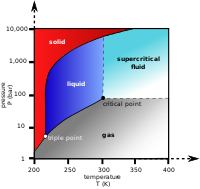
Photo from wikipedia
The increasing demand for energy all around the world has led to a rise in greenhouse gases (GHGs), of which carbon dioxide (CO2) is the most important. CO2 is largely… Click to show full abstract
The increasing demand for energy all around the world has led to a rise in greenhouse gases (GHGs), of which carbon dioxide (CO2) is the most important. CO2 is largely responsible for global warming and climate change. Processes such as carbon dioxide capture and storage (CCS), which have an effective role in climate mitigation, seem to be promising. In recent years, porous carbons, particularly activated carbons (ACs), have rapidly emerged as one of the most effective adsorbents of CO2. However, the implementation of pristine ACs in the real world is still hindered due to their physical and weak adsorption, which makes these adsorbents sensitive to temperature and relatively poor in selectivity. Hence, the surface modification of ACs is essential in order to improve their surface area, pore structure and alkalinity. Numerous studies have reported lignocellulose-based ACs as very promising adsorbents of CO2. In this review, the sources, health and environmental effects of CO2, and the abatement methods of GHGs are described. In addition, the capture and separation of CO2 from gas stream using various types of lignocellulose-based ACs are summarized. Furthermore, the key factors controlling the adsorption of CO2 by ACs (characteristics of adsorbents, preparation conditions, as well as adsorption conditions) are comprehensively and critically discussed. Finally, future research needs and prospective research challenges are summarized.
Journal Title: Chemosphere
Year Published: 2019
Link to full text (if available)
Share on Social Media: Sign Up to like & get
recommendations!